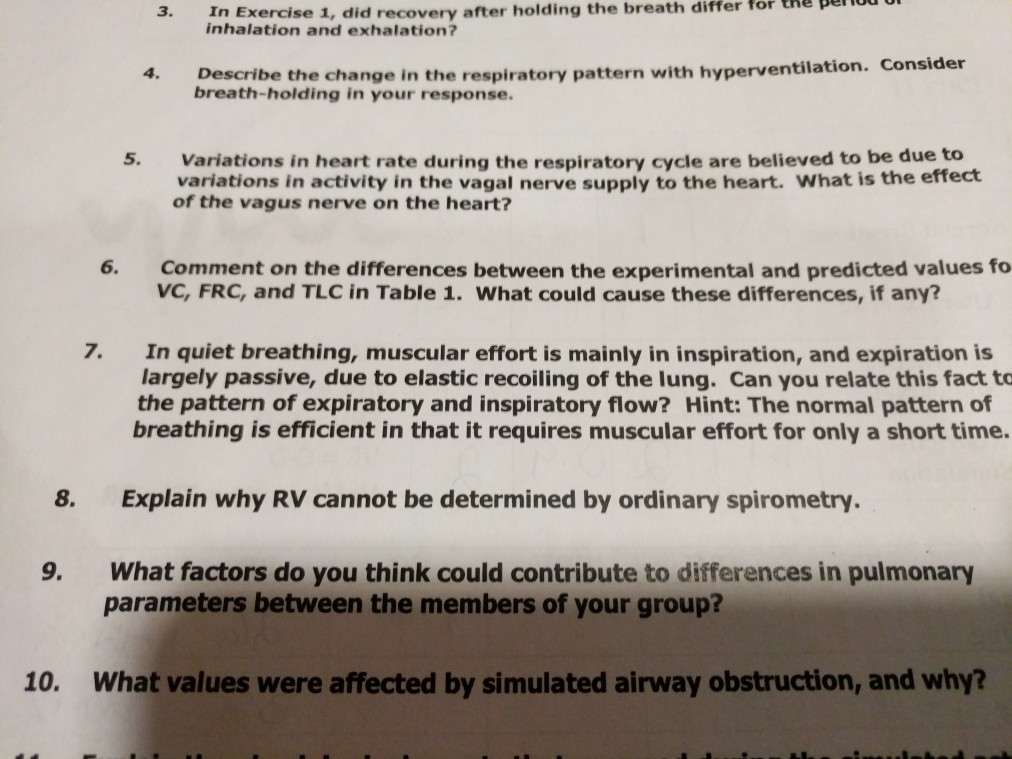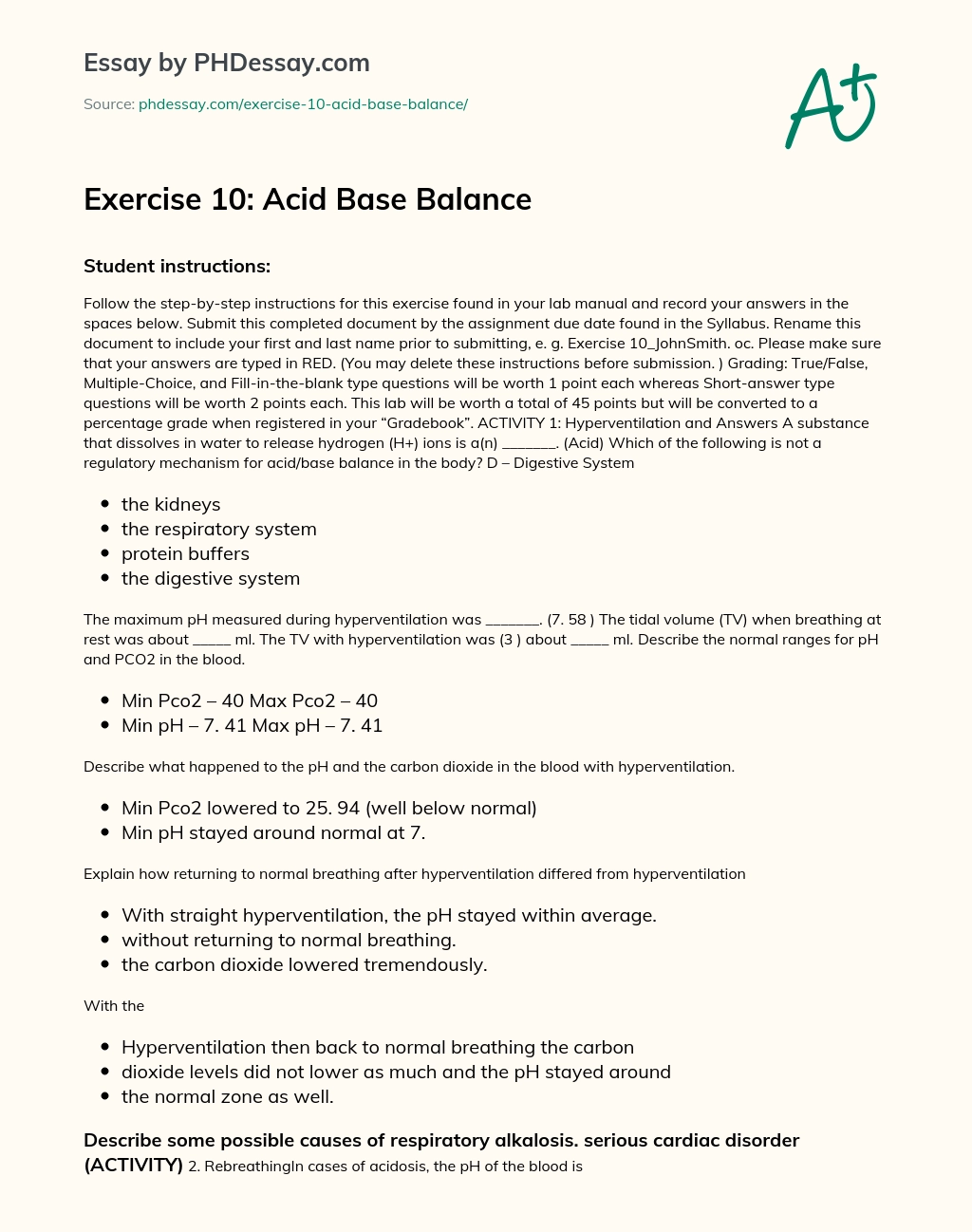During hyperventilation there is too deep and too. The carbon dioxide lowered tremendously.

Solved 3 Tn Exercise 1 Did Recovery After Holding The Chegg Com
Each chart table or drawing should have the following item.

. What might cause a person to hyperventilate. Returning to normal breathing after hyperventilation brought the p H level to 738- 749 and Pco ₐ to 3374 - 40 which indicates that p H level became normal and carbon dioxide level remained a bit lower than normal. Returning to normal breathing after hyperventilation caused the min.
3 Describe some possible causes of respiratory alkalosis. Feeling faint dizzy or lightheaded. What was the effect of returning to normal breathing after hyperventilation.
Fever or anxiety can cause hyperventilation. Did the tidal volumes change. A faster than normal heartbeat.
Min pH stayed around normal at 7. Hyperventilation 19 40 7 7. Explain how returning to normal breathing after hyperventilation differed from hyperventilation without returning to normal breathing.
Describe what happened to the pH and the carbon dioxide levels with hyperventilation. How did the hyperventilation trace differ from the trace for the normal breathing. Explain how returning to normal breathing after hyperventilation differed from hyperventilation without returning to normal breathing.
This is a perfectly normal reaction. Describe the normal ranges for pH and carbon dioxide in the blood. Experts are tested by Chegg as specialists in their subject area.
The carbon dioxide lowered tremendously. What charts tables or drawings would clearly show what you have learned in this lab. Explain how returning to normal breathing after.
Explain how returning to normal breathing after hyperventilation differed from hyperventilation without returning to normal breathing. Hyperventilation occurs when you start breathing very quickly. Pain or tightness in your chest.
Explain how returning to normal breathing after hyperventilation differed from hyperventilation without returning to normal breathing. What charts tables or drawings would clearly show what you have learned in this lab. Explain how returning to normal breathing after hyperventilation differed from hyperventilation without returning to normal breathing.
Explain how returning to normal breathing after hyperventilation differed from hyperventilation without returning to normal breathing. Explain how returning to normal breathing after hyperventilation differed from hyperventilation. After hyperventilation the respiratory rate is slower than respiratory rate during normal breathing.
By switching from hyperventilation to normal breathing the body was attemtpting to save some carbo dioxide in the blood by seassing the breating temporarly unlike constant hyperventalation that persists to. This can lead to lightheadedness and loss of consciousness. Condition Min PCO2 Max PCO2 Min pH Max pH Normal 40 40 7 7.
Chemoreceptor sense this change and decreased the respiratory rate to reduce the amount of CO2 being exhaled and thus PCO2 in. When returning to normal breathing respiration stops completely for approximately ten seconds in order to help build up the amount of CO2 before returning to normal breathing after hyperventilation. Returning to normal breathing from hyperventilation differed due to the breathing pattern changed to replenish the CO2.
Exhaling more than you inhale causes low carbon dioxide levels in your body. Explain how returning to normal breathing after hyperventilation differed from hyperventilation without returning to normal breathing. Hyperventilation then back to normal breathing the carbon.
Explain how returning to normal breathing after hyperventilation differed from hyperventilation With straight hyperventilation the pH stayed within average and without returning to normal breathing. Both pH and PCO2 were in the normal range. The trace was erratic and the tidal volume increased to approximately 3 liters.
Also in order to return to normal breathing after hyperventilating there is a brief period of about 10 seconds during which the breath is held to retain some CO. Was me opposite of what actually haprongo. Hyperventilation Hyperventiltion means breathing in excess of the bodys requirements.
When there is a return to normal breathing there is a brief period of about 10 second where the breath is held in order to retain CO2 before returning to normal breathing after hyperventilation to normal breathing. Explain how returning to normal breathing after hyperventilation differed from hyperventilation without returning tonormal breathing. Hyperventilation Run 21.
Hyperventilation can produce a number of frightening. Explain how returning to normal breathing after hyperventilation differed from hyperventilation without returning to normal breathing. Explain how returning to normal breathing after hyperventilation differed from hyperventilation without returning to normal breathing.
With the second hyperventilation there was a period where the breath was held and this was instrumental in retaining carbon. Who are the experts. Hyperventilation Normal 35 40 7 7.
Describe some possible causes of respiratory alkalosis. Without returning to normal breathing. During hyperventilation pH increased and PCO2 decreased.
Most people will have experienced a short period of over breathing hyperventilation at some time caused by stress or over excitement. We review their content and use your feedback to keep the quality high. Frequent yawn or sighs.
Describe some possible causes of respiratory alkalosis. With hyperventilation the pH rises and CO2 decreases. The breathing stopped temporarily to retain carbon dioxide.
Explain how returning to normal breathing after hyperventilation differed from hyperventilation without returning to normal breathing. With straight hyperventilation the pH stayed within average. Explain how returning to normal breathing after hyperventilation differed from hyperventilation without returning to normal breathing.
Shortness of breath or feeling that you cant get enough air.

Exercise 10 Acid Base Balance Phdessay Com

Exercise 10 Pdf Respiratory System Bicarbonate

Physio Ex Exercise 10 Activity 1 Hyperventilation Physioex Lab Report Exercise 10 Acid Base Studocu

0 Comments